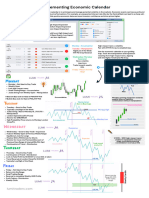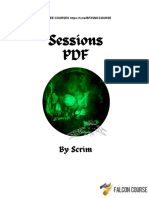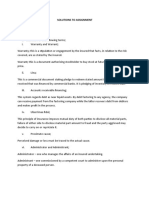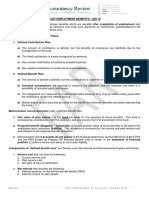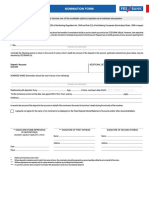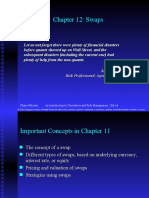BUILDING A TRADING
MODEL/STRATEGY
Eleven_Trades
�Introduction
A trading model is a framework or edge that gives a trader a high probability of one outcome over another, as stated by
Mark Douglas. This document will outline the process of building a structured trading model by integrating the teachings
of various mentors and concepts.
Acknowledgments
Thank you to ICT, MMXM Trader, TTrades, AM Trades, Sniper Trades for their insights. I do not claim ownership over
these concepts.
Eleven_Trades
�Step 1: Establishing Market Direction
To trade the market effectively, we need to determine where the price is going and from where it is going. As an
intraday trader, this means identifying the daily bias—the expected direction of the daily candle.
To determine daily bias, we must build a narrative by:
Understanding Order Flow.
Defining Key Levels
Where is it going? → DOL
From where is it going? → Point of Interest
Recognizing Price Action Phases
IRL to ERL and ERL to IRL is a universal price behavior.
Identifying swing points within POIs to refine trade entries.
Eleven_Trades
�Revisiting The MMXM’s Next Day Model/TTFM
A swing point consists of three candles:
C1: First candle.
C2: Second candle, which takes out the previous candle’s high or low.
C3: Third candle, which reverses direction.
According to the Next Day Model, price expands in the direction of the DOL whenever it closes above/below the
previous candle until the draw is met.
Eleven_Trades
�The MMXM’s Next Day Model/TTFM
50%
50%
50%
�Top-Down Analysis
Daily Chart:
Find the direction of the next daily candle to align intraday trades.
Determine phase of price delivery and order flow.
Use MMXM Next Day Model at relevant POIs (IRL & ERL).
The draw would be external range liquidity.
4H Chart:
A single daily candle contains six 4H candles.
Identify which 4H candle will form the high/low of the day.
Use 4H order flow and IRL to ERL structure for bias confirmation.
When the daily chart is unclear, use 4H chart analysis (except during consolidation).
Bullish Order Flow: Look for higher highs (HH) and higher lows (HL) with bullish PD arrays being respected.
Eleven_Trades
�SMT Divergence (Compulsory for This Model)
Increases win rate by 8-12%.
Confirms reversals.
Mandatory before trading reversal candles.
Eleven_Trades
�4H-M15 MODEL
Eleven_Trades
�4H to M15 Entries (Bread & Butter Entries)
Entry Conditions:
Order Flow must align.
4H profiling & Swing point formation at relevant PD arrays.
SMT Divergence at swing point/high/low.
M15 CISD (Closure below/above a series of opposing close candles).
Entries post 8:00 AM, unless news at 8:30 AM (wait for reaction).
Rules & Cautions:
CISD should happen instantly.
No counter-trend trades.
If CISD is far above, take IFVG entries.
No consolidation prior to CISD.
No contradictory swings (Bullish & Bearish swings cannot coexist).
No trades post 11:00 AM.
No SMT → No trade.
Eleven_Trades
�Continuation Entries (4H to M15)
If reversal entry fails:
Look for continuation entries meeting all previous criteria.
Continuation Candle: Always the 3rd candle of the swing point.
Entry Conditions:
Small wick → Large body expected.
Opposing move creates an OB → Enter expansion with small stop.
Wait for opposing run before entering.
Continuation Protocol 2:
If C2 has CISD but no entry, wait for an order block or propulsion block within C2.
Eleven_Trades
� 10:00
6:00
SMT
8:00
�1H-M5 MODEL
Eleven_Trades
�1H to M5 Entries
4 x 1H candles = 1- 4H candle → If the next 4H candle expands, the next four 1H candles expand too.
Position within first 1H candles of a new 4H expansion.
Wait for swing point formation.
Catching the 2nd Candle of the Swing Point:
SMT Divergence (Compulsory).
M5 CISD.
No consolidation on M5 or 1H prior to entry.
Entry post 8:00 AM.
POI for swing point:
FVG, IRL to ERL.
Old high or low.
Eleven_Trades
�Continuation Entries/TTFM logic (1H to M5)
If reversal entry fails:
Look for continuation entries meeting all previous criteria.
Continuation Candle: Always the 3rd candle of the swing point.
Entry Conditions:
Small wick → Large body expected.
Opposing move creates an OB → Enter expansion with small stop.
Eleven_Trades
�1H M5
4H
new hourly candle
6:00
8:00am
T
SM
�Socials:
https://discord.com/invite/dYDbCX5QaV
https://x.com/Eleven_trades
https://www.youtube.com/@Eleven_trades
Eleven_Trades



















































